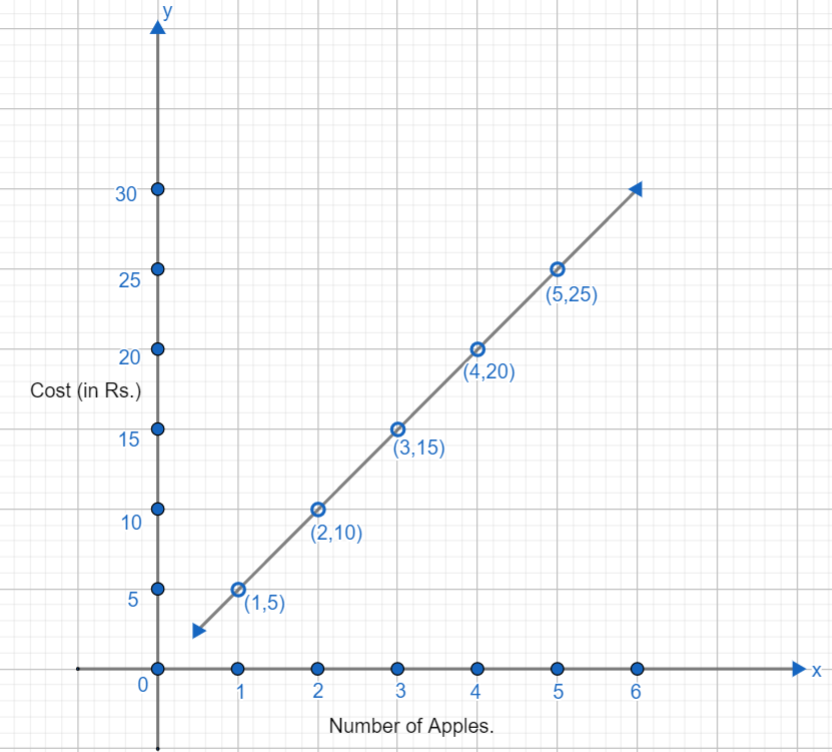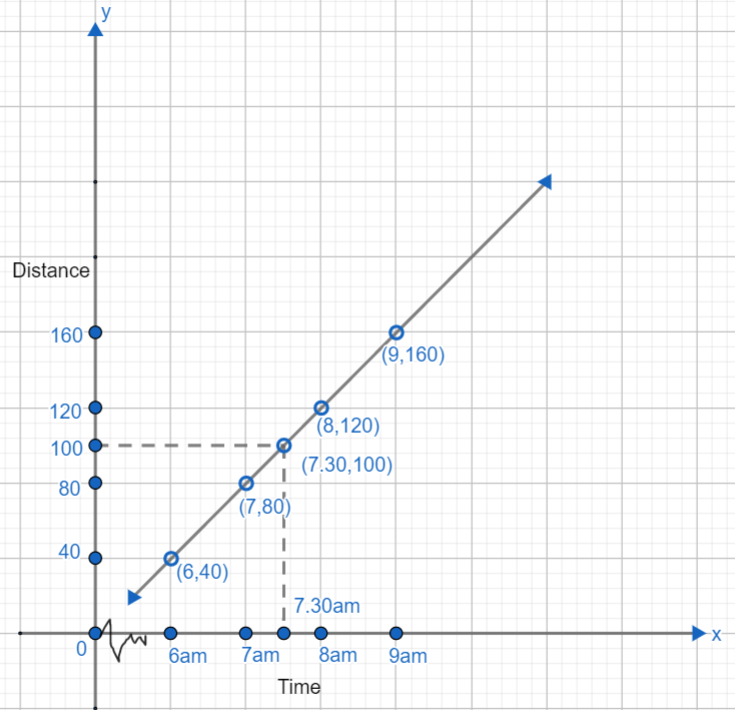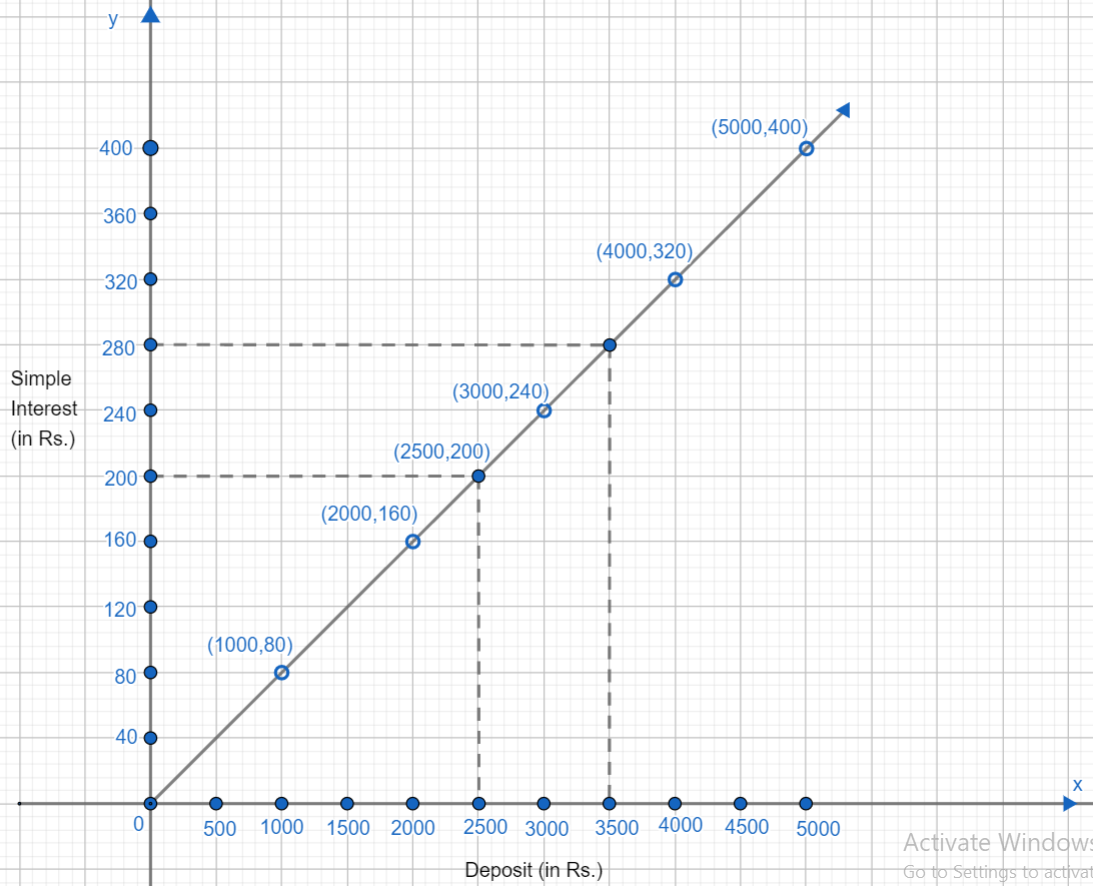
Draw the graph for the following values, with suitable scale on the axis.
(a) Cost of apples.
Number of Apples 1 2 3 4 5 Cost (in Rs.) 5 10 15 20 25
(b) Distance travelled by car.
Time (in hours) 6am 7am 8am 9am Distance (in Km.) 40 80 120 160
(i) How much distance did the car cover during the period 7.30 am to 8 am?
(ii) What was the time when the car had covered a distance of 100 km since its start?
(c) Interest on deposit for a year.
Deposit (in Rs.) 1000 2000 3000 4000 5000 Simple Interest (in Rs.) 80 160 240 320 400
(i) Does the graph pass through the origin?
(ii) Use the graph to find the interest on Rs. 2500 for a year.
(iii) To get an interest of Rs.280 per year, how much money should be deposited?
| Number of Apples | 1 | 2 | 3 | 4 | 5 |
| Cost (in Rs.) | 5 | 10 | 15 | 20 | 25 |
| Time (in hours) | 6am | 7am | 8am | 9am |
| Distance (in Km.) | 40 | 80 | 120 | 160 |
| Deposit (in Rs.) | 1000 | 2000 | 3000 | 4000 | 5000 |
| Simple Interest (in Rs.) | 80 | 160 | 240 | 320 | 400 |
Answer
561.6k+ views
Hint: In this question, we have to draw graphs for three parts.
For (a), we will take a number of apples on the x axis with a scale of 1 apple for 1 unit and we will take cost (in Rs.) on y axis with a scale of Rs.5 for 1 unit.
For (b), we will take time on the x axis with value starting from 6 am and take one hour for every unit. We will take distance on y axis with a scale of 40 km for 1 unit. Using the graph drawn, we will answer given two sub parts.
For (c), we will take a deposit on the x axis with a scale of Rs.500 for 1 unit and we will take a simple interest on y axis with scale of Rs.40 for 1 unit. Using the graph drawn, we will answer the given sub parts.
Complete step by step answer:
Let us draw graph for (a) first,
We will take a number of apples on the x axis with a scale of 1 apple for 1 unit and we will take cost (in Rs.) on y axis with a scale of Rs.5 for 1 unit. Coordinates become:
(1,5), (2,10), (3,15), (4,20), (5,25)

Now, let us draw graph for (b),
We will take time on the x axis with value starting from 6 am and take one hour for every unit. We will take distance on y axis with a scale of 40 km for 1 unit. Coordinates become:
(6,40), (7,80), (8,120), (9,160)

We have to calculate the distance covered during 7.30 and 8 am. As we know, distance covered at 8 am is given as 120. From the graph, draw a line from 7.30 am to the line joining coordinates, from there we see that it corresponds to 100km on y axis. Hence, the distance covered at 7.30 am is 100 km.
Distance covered between 7.30 am and 8 am = Distance at 8 am - Distance at 7.30 am.
Distance covered between 7.30 am and 8 am = 120 – 100 = 20 Km.
(i) Distance covered between 7.30 am to 8 am is 20 km.
(ii) As we have seen in the previous part that at 7.30 am, 100 km distance was covered. So, at 7.30 am the car covered 100 km distance.
Now, let us draw a graph for (c). Coordinates become:
(1000,80), (2000,160), (3000,240), (4000,320), (5000,400)
We will take a deposit on the x axis with a scale of Rs.500 as 1 unit and simple interest on the y axis with a scale of Rs.40 as 1 unit.

Let us solve sub parts using graph:
(i) As we can clearly see from the graph, the line joining coordinates passes through origin.
(ii) For Rs.2500 on x axis, draw line from x axis to the line joining coordinate, we get that Rs.200 on y axis corresponds to the value of Rs.2500 on x axis. Hence, interest on Rs.2500 is Rs.200
(iii) For Rs.280 on y axis, draw line from y axis to line joining coordinate, we get that Rs.3500 on x axis corresponding to the value of Rs.280 on y axis.
Hence, we get interest of Rs.280, we should deposit Rs.3500
Note: Students should carefully draw graphs by taking proper scale on x axis and y axis. Don't forget to write quantities taken on x axis and y axis. Students can take different scales also, such as for (b) they can take a scale of 20 km as 1 unit on y axis. While calculating values from the graph, make sure that you draw perpendicular lines.
For (a), we will take a number of apples on the x axis with a scale of 1 apple for 1 unit and we will take cost (in Rs.) on y axis with a scale of Rs.5 for 1 unit.
For (b), we will take time on the x axis with value starting from 6 am and take one hour for every unit. We will take distance on y axis with a scale of 40 km for 1 unit. Using the graph drawn, we will answer given two sub parts.
For (c), we will take a deposit on the x axis with a scale of Rs.500 for 1 unit and we will take a simple interest on y axis with scale of Rs.40 for 1 unit. Using the graph drawn, we will answer the given sub parts.
Complete step by step answer:
Let us draw graph for (a) first,
We will take a number of apples on the x axis with a scale of 1 apple for 1 unit and we will take cost (in Rs.) on y axis with a scale of Rs.5 for 1 unit. Coordinates become:
(1,5), (2,10), (3,15), (4,20), (5,25)

Now, let us draw graph for (b),
We will take time on the x axis with value starting from 6 am and take one hour for every unit. We will take distance on y axis with a scale of 40 km for 1 unit. Coordinates become:
(6,40), (7,80), (8,120), (9,160)

We have to calculate the distance covered during 7.30 and 8 am. As we know, distance covered at 8 am is given as 120. From the graph, draw a line from 7.30 am to the line joining coordinates, from there we see that it corresponds to 100km on y axis. Hence, the distance covered at 7.30 am is 100 km.
Distance covered between 7.30 am and 8 am = Distance at 8 am - Distance at 7.30 am.
Distance covered between 7.30 am and 8 am = 120 – 100 = 20 Km.
(i) Distance covered between 7.30 am to 8 am is 20 km.
(ii) As we have seen in the previous part that at 7.30 am, 100 km distance was covered. So, at 7.30 am the car covered 100 km distance.
Now, let us draw a graph for (c). Coordinates become:
(1000,80), (2000,160), (3000,240), (4000,320), (5000,400)
We will take a deposit on the x axis with a scale of Rs.500 as 1 unit and simple interest on the y axis with a scale of Rs.40 as 1 unit.

Let us solve sub parts using graph:
(i) As we can clearly see from the graph, the line joining coordinates passes through origin.
(ii) For Rs.2500 on x axis, draw line from x axis to the line joining coordinate, we get that Rs.200 on y axis corresponds to the value of Rs.2500 on x axis. Hence, interest on Rs.2500 is Rs.200
(iii) For Rs.280 on y axis, draw line from y axis to line joining coordinate, we get that Rs.3500 on x axis corresponding to the value of Rs.280 on y axis.
Hence, we get interest of Rs.280, we should deposit Rs.3500
Note: Students should carefully draw graphs by taking proper scale on x axis and y axis. Don't forget to write quantities taken on x axis and y axis. Students can take different scales also, such as for (b) they can take a scale of 20 km as 1 unit on y axis. While calculating values from the graph, make sure that you draw perpendicular lines.
Recently Updated Pages
Why is there a time difference of about 5 hours between class 10 social science CBSE

In cricket, what is a "pink ball" primarily used for?

In cricket, what is the "new ball" phase?

In cricket, what is a "death over"?

What is the "Powerplay" in T20 cricket?

In cricket, what is a "super over"?

Trending doubts
Who was the first woman to receive Bharat Ratna?

Write a letter to the principal requesting him to grant class 10 english CBSE

What is the median of the first 10 natural numbers class 10 maths CBSE

The Equation xxx + 2 is Satisfied when x is Equal to Class 10 Maths

Who Won 36 Oscar Awards? Record Holder Revealed

Discuss the main reasons for poverty in India




